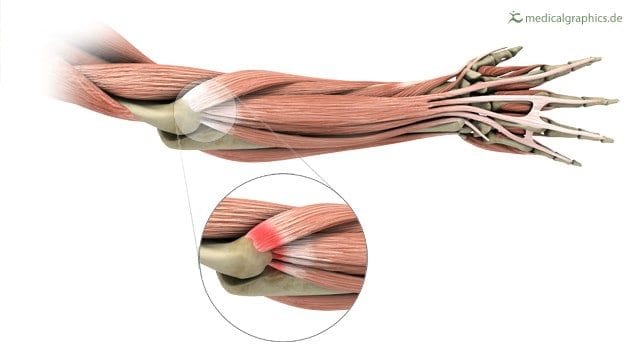FITNESS AND WELLNESS
Understanding Tennis Elbow

The most commonly injured muscle in ‘Tennis Elbow’ is the Extensor Carpi Radialis Brevis. (image courtesy of medicalgraphics.de)
First of all, you don’t need to be Roger Federer, Serena Williams, or even a tennis player to suffer from ‘Tennis Elbow’. Tennis Elbow is a common injury and is the generic term used when you suffer from pain on the outside of your elbow. It is typically caused by overusing your wrist and forearm muscles. The medical terms most commonly used are “Lateral Epicondylitis” or “Lateral Epicondylalgia.” Whether you’re a weekend warrior in the gym, an amateur tennis player who thrives on competition, a manual laborer, or even an office worker, you’re more susceptible to Tennis Elbow than you may think.
What Is Tennis Elbow?
Tennis Elbow is generally seen when the wrist extensors, the muscles on the back of your forearm that attach to your wrist to help bend your hand up/back, are over-used and over-stressed – typically with poor body mechanics leading to further break down. This is such a common injury that not only do we see this often in our clinic, but Tennis Elbow accounts for over 12% of all workplace injuries. Just like changing your running shoes can alter the way you run and cause knee pain, there are many things that could cause elbow pain, including:
- Changing your racquet strings and/or grip size
- Increased activity levels that you aren’t used to (paint your walls recently?)
- Lifting objects that are heavier or more repetitively than normal
- Repetitive gripping activities
- Non-neutral wrist positions like twisting and rotating screw drivers or computer mice and keyboards
The worst part about Tennis Elbow is the length of time it can linger and effect your everyday activities (not to mention your tennis game), if not addressed correctly. Tennis Elbow can be a cruel beast that has been known to persist for over four years at a time and consistently reoccur when correct management hasn’t been sought.
What’s the Difference Between Epicondylitis and Epicondylalgia?
We often are asked this question and it all comes down to tissue healing and what stage of recovery your muscles and tendon are in. When dealing with injuries, we need to understand what stage of injury you are in to help guide our initial treatments and activities. Below is a table to better help your understanding of the stages of healing that take place within the body and how they help with your recovery:
| Acute | Sub-Acute | Chronic | |
| Time-Frame | 1-3 Days | 4 Days – 3 Months | > 3 Months |
| Medical Terminology | “-itis” | “-itis” | “-opathy”, “-algia” |
| Characteristics | Active Inflammation Redness and Swelling |
Tissue Repair Becomes Stronger | Scar Tissue Forms Tendon, Tissue Breakdown & Stalled Recovery Potentially Poor Circulation |
Quick Tip
Whenever you see ‘itis’ on the end of a word, think ‘active inflammation’. ‘Opathy’ on the other hand typically refers to chronic problems and tissue breakdown.
So, Do I Have Tennis Elbow?
If you are experiencing any of the below symptoms, then chances are you may have some form of Tennis Elbow:
- Sharp pain on the outside of your forearm and/or elbow during activity
- Difficulty with gripping due to sharp pain
- Decreased grip strength, which is limited by pain and discomfort
Here are four things that you may be doing now that could be sabotaging your healing and delaying your recovery:
- Needing to pop pain pills before your tennis match/work/painting etc.
- Stopping the activities you love for fear of worsening your symptoms
- Being forced to wear compression forearm braces and hoping it helps give you relief
- Having injections to help numb the pain, only for it to return after a few weeks
Any of the above sound like you? If so, check back next week to this column for some self-treatments and to get yourself back on track and doing the things you love.
Matthew Turner
A native of Sheffield, England, Matthew Turner moved to North Carolina in 2016, with his wife Rachael, and has worked in an outpatient orthopedic setting, specializing in manual therapy. Matt is the Facility Director and lead physical therapist for the PHOENIX Rehabilitation and Health Services, Charlotte location. Matt's clinical expertise focuses on outpatient orthopedics, post-operative conditions, concussion, and sports/work-related injuries. Matt underwent post-graduate training with NAIOMT and is a Certified Manual Physical Therapist. He is also certified in Dry Needling and Blood Flow Restriction Training.


